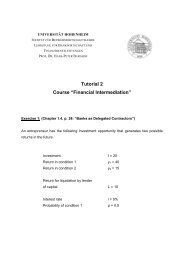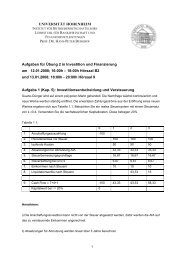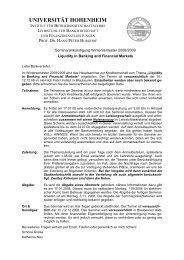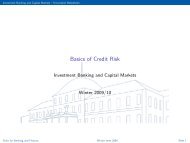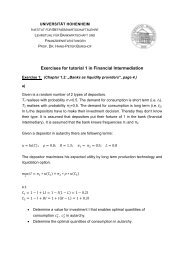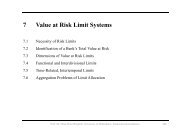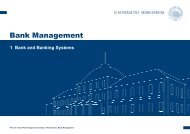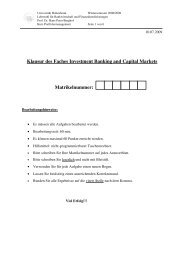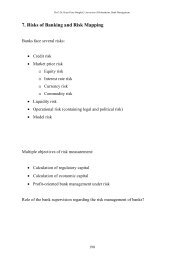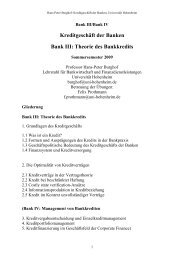6 Bank Supervision by Norm Setting and Intervention 6.1 Institutions ...
6 Bank Supervision by Norm Setting and Intervention 6.1 Institutions ...
6 Bank Supervision by Norm Setting and Intervention 6.1 Institutions ...
Create successful ePaper yourself
Turn your PDF publications into a flip-book with our unique Google optimized e-Paper software.
Prof. Dr. Hans-Peter Burghof, University of Hohenheim, <strong>Bank</strong> Management<br />
6 <strong>Bank</strong> <strong>Supervision</strong> <strong>by</strong> <strong>Norm</strong> <strong>Setting</strong> <strong>and</strong> <strong>Intervention</strong><br />
<strong>6.1</strong> <strong>Institutions</strong> of <strong>Bank</strong> <strong>Supervision</strong><br />
Since 2002: Creation of a regulatory authority for financial institutions covering<br />
the entire financial spectrum <strong>by</strong> combining the formerly separate supervisory<br />
authorities for lending, insurance <strong>and</strong> security trading.<br />
Exchange supervision remains under the responsibility of the federal states<br />
Cooperation with Deutsche Bundesbank<br />
166
<strong>Bank</strong><br />
S<strong>Supervision</strong><br />
Executive<br />
Director<br />
LLautenschlägerr<br />
Major bannks<br />
L<strong>and</strong>esbankken,<br />
savings bannks,<br />
Bausparkasssen<br />
Credit bannks,<br />
specializeed<br />
banks, brokkers,<br />
mortgagge<br />
banks<br />
Genossenscchaft<br />
sbankenn<br />
Policy<br />
departmeent<br />
Prof. Dr. Hanns-Peter<br />
Burghoff,<br />
University of Hohenheim, H <strong>Bank</strong> Management<br />
Bundeesanstalt<br />
für Finannzdienstle<br />
eistungsauufsicht<br />
(BBaFin):<br />
Inside<br />
Ad dministrationn<br />
Executive<br />
Director<br />
Sell<br />
Money<br />
launder-ing<br />
Informationtechnology<br />
Risk <strong>and</strong><br />
financial<br />
market<br />
analysis<br />
Investor<br />
<strong>and</strong><br />
consumer<br />
protection<br />
Integrity of<br />
the<br />
financial<br />
system<br />
Cross<br />
section,<br />
risk<br />
modeling<br />
Central<br />
tasks<br />
Prresident<br />
Sanio<br />
PR <strong>and</strong><br />
innternal<br />
auditt<br />
Internal<br />
topics<br />
167<br />
Assurance/<br />
Pennsion<br />
Fund<br />
<strong>Supervision</strong><br />
Execuutive<br />
Director<br />
N.N.<br />
RRetirement<br />
annd<br />
health<br />
insurance<br />
LLife<br />
insurance,<br />
burial fundss<br />
National<br />
accident <strong>and</strong>d<br />
indemnity<br />
insurance<br />
International<br />
insurance<br />
companies<br />
Policy<br />
department<br />
<strong>Supervision</strong> oof<br />
Securities<br />
Executive<br />
Director<br />
Caspari<br />
Takeoverss,<br />
major<br />
shareholdeer<br />
Insider <strong>and</strong>d<br />
market<br />
monitoringg<br />
FDI <strong>and</strong><br />
good<br />
conduct<br />
rules<br />
Investmentt<br />
funds
Supervisory <strong>Norm</strong> <strong>Setting</strong><br />
Sources of law:<br />
Prof. Dr. Hans-Peter Burghof, University of Hohenheim, <strong>Bank</strong> Management<br />
Kreditwesengesetz (KWG)<br />
Laws <strong>and</strong> ordinances<br />
Announcements of the BaFin<br />
Mainly: implementation of international law-setting<br />
a) European Union (“Richtliniengesetzgebung”):<br />
Level playing field<br />
b) Basel Committee on bank supervision:<br />
Operability of the international financial markets<br />
168
Prof. Dr. Hans-Peter Burghof, University of Hohenheim, <strong>Bank</strong> Management<br />
International Harmonization <strong>and</strong> Basel Committee:<br />
Developing free global markets of goods <strong>and</strong> capital<br />
Highly interdependent national markets because of cash flows <strong>and</strong><br />
capital flows<br />
Global necessity for harmonized bank supervision legislation<br />
E.U. bank supervision law<br />
E.U. security supervision law<br />
Bilateral contracts<br />
169<br />
Basel Committee<br />
Forums of national bank supervisory<br />
authorities
Self-CConceptiion<br />
of thhe<br />
Basel CCommit<br />
ttee:<br />
The Basel<br />
Commmittee<br />
onn<br />
<strong>Bank</strong> Suupervision<br />
n<br />
The Baasel<br />
Commmittee,<br />
established<br />
<strong>by</strong> the ce entral-bankk<br />
Governoors<br />
of the Group<br />
of Tenn<br />
countries<br />
at the eend<br />
of 19774,<br />
meets regularlyy<br />
four timmes<br />
a year.<br />
It has<br />
about tthirty<br />
techhnical<br />
worrking<br />
grouups<br />
<strong>and</strong> tas sk forces wwhich<br />
alsoo<br />
meet reg gularly.<br />
The CCommitteee's<br />
membeers<br />
come from Be elgium, Canada,<br />
Frrance,<br />
Ge ermany,<br />
Italy, JJapan,<br />
Luxxembourgg,<br />
the Nethherl<strong>and</strong>s,<br />
Spain, S Swweden,<br />
Swiitzerl<strong>and</strong>,<br />
United<br />
Kingdoom<br />
<strong>and</strong> UUnited<br />
Stattes.<br />
Counttries<br />
are re epresentedd<br />
<strong>by</strong> their central ba ank <strong>and</strong><br />
also <strong>by</strong>y<br />
the authority<br />
withh<br />
formal reesponsibil<br />
lity for thee<br />
prudential<br />
supervi ision of<br />
bankinng<br />
business<br />
where thhis<br />
is not tthe<br />
central l bank. Thhe<br />
present Chairman n of the<br />
Commmittee<br />
is MMr.,<br />
Presiddent<br />
<strong>and</strong> CEO of the t Federral<br />
Reservve<br />
<strong>Bank</strong> of o New<br />
York.<br />
The CCommitteee<br />
does nnot<br />
possesss<br />
any fo ormal suupranationnal<br />
super rvisory<br />
authorrity,<br />
<strong>and</strong> iits<br />
concluusions<br />
do nnot,<br />
<strong>and</strong> were w neveer<br />
intendeed<br />
to, hav ve legal<br />
force. Rather, iit<br />
formulaates<br />
broadd<br />
supervis sory st<strong>and</strong>dards<br />
<strong>and</strong>d<br />
guidelin nes <strong>and</strong><br />
recommmends<br />
staatements<br />
countriies'<br />
supervvisory<br />
techhniques.<br />
Prof. Dr. Hanns-Peter<br />
Burghoff,<br />
University of Hohenheim, H <strong>Bank</strong> Management<br />
of best ppractice<br />
in i the exxpectationn<br />
that ind dividual<br />
authoriities<br />
will take stepss<br />
to impleement<br />
the em througgh<br />
detailedd<br />
arrangem ments -<br />
statutoory<br />
or otheerwise<br />
- wwhich<br />
are best suite ed to theirr<br />
own natiional<br />
syste ems. In<br />
this waay,<br />
the Coommittee<br />
encouragees<br />
converg gence towwards<br />
commmon<br />
appr roaches<br />
<strong>and</strong> coommon<br />
st<strong>and</strong>ards<br />
wwithout<br />
atttempting<br />
detailed hharmonizaation<br />
of member<br />
m<br />
?<br />
170
Prof. Dr. Hans-Peter Burghof, University of Hohenheim, <strong>Bank</strong> Management<br />
Basel Committee <strong>and</strong> Equity St<strong>and</strong>ards<br />
Basel I:<br />
Basel equity recommendation<br />
(1988, Basel Capital Adequacy Framework)<br />
Consistent equity requirements for international banks<br />
Amendment of equity requirements: inclusion of market risks<br />
(1996, Amendment)<br />
St<strong>and</strong>ardized measuring methods <strong>and</strong> internal models to capture interest risks,<br />
stock price risks, foreign exchange rate risks <strong>and</strong> commodity price risks<br />
Basel II:<br />
A New Capital Adequacy Framework, in consultation since June 1999<br />
Three pillars concept:<br />
Pillar 1: Minimum capital requirements (particularly special norm for<br />
credit risks)<br />
Pillar 2: <strong>Supervision</strong> of equity norms (qualitative supervision)<br />
Pillar 3: Market discipline (due to transparency)<br />
171
Basel III:<br />
Prof. Dr. Hans-Peter Burghof, University of Hohenheim, <strong>Bank</strong> Management<br />
Basel III - Representation of a fundamental amplification of global capital<br />
st<strong>and</strong>ards<br />
Key features:<br />
Substantially raise the quality of banks’ capital<br />
Considerably raise the required level of banks’ capital<br />
Reduction of systemic risk<br />
Allow sufficing time for a smooth transition to the new requirements<br />
a) Better capital quality<br />
Greater focus on common equity (i.e. core capital)<br />
Stricter definition of core capital:<br />
Under Basel III, the deductions of certain types of assets of<br />
questionable quality from capital base (i.e. Tier 1 <strong>and</strong> Tier 2)<br />
will be stricter as they will be deducted directly form core<br />
capital<br />
Accentuation of the definition of Tier 1 capital:<br />
Now Tier 1 capital includes common equity <strong>and</strong> other<br />
qualifying financial instruments based on tight criterion<br />
172
Prof. Dr. Hans-Peter Burghof, University of Hohenheim, <strong>Bank</strong> Management<br />
b) More capital (Basel II requirements in brackets)<br />
Increase of the minimum core capital requirements:<br />
4.5% (2%)<br />
Increase of the Tier 1 minimum capital requirements:<br />
6% (4%)<br />
Requirement to hold a capital conservation buffer of 2.5% of core capital<br />
c) System-oriented overlay<br />
Countercyclical capital buffer with a range of 0 to 2.5% to tackle system-<br />
wide risks<br />
Target is to reduce pro-cyclicality of the financial system:<br />
Buffer will have to be built up during periods of huge<br />
aggregate credit buffer<br />
During the downturn of the financial cycle buffer will have<br />
to be released<br />
(In development: Basel IV)<br />
173
Prof. Dr. Hans-Peter Burghof, University of Hohenheim, <strong>Bank</strong> Management<br />
6.2 Characterization of <strong>Bank</strong> <strong>Supervision</strong> <strong>Norm</strong>s<br />
Interaction between preventive <strong>and</strong> protective actions<br />
Preventive<br />
actions<br />
...are essential to keep banks from<br />
taking too high risks. This would<br />
increase the costs of protective<br />
actions.<br />
...establish trust among the<br />
depositors <strong>and</strong> thus are<br />
preventive.<br />
174<br />
Protective<br />
actions
Prof. Dr. Hans-Peter Burghof, University of Hohenheim, <strong>Bank</strong> Management<br />
Forms of <strong>Bank</strong> <strong>Supervision</strong> <strong>Norm</strong>s<br />
Discretionary<br />
actions<br />
Self-regulation<br />
through market<br />
forces<br />
Protective actions<br />
Regulation of the banking<br />
sector<br />
Contractual<br />
intervention<br />
Selective<br />
norms<br />
175<br />
Governmental<br />
regulation<br />
Preventive actions<br />
= norm setting<br />
Quantitative<br />
norms<br />
Comprehensive<br />
norms<br />
Qualitative<br />
norms
Preventive Actions<br />
I. Quantitative <strong>Norm</strong>s, e.g.<br />
Equity norms<br />
Liquidity principles<br />
Dictate of diversification<br />
- Disaggregation of risk<br />
- Distribution of risk<br />
Prof. Dr. Hans-Peter Burghof, University of Hohenheim, <strong>Bank</strong> Management<br />
176
II. Qualitative <strong>Norm</strong>s<br />
Business limitations<br />
Accreditation requirements<br />
Information publishing<br />
Accounting regulation<br />
Other rules of regulation:<br />
Prof. Dr. Hans-Peter Burghof, University of Hohenheim, <strong>Bank</strong> Management<br />
- Minimum requirements for the operation of trading transactions (MaH)<br />
- Minimum requirements for the forming of the internal revision<br />
- Minimum requirements for the credit business (MaK)<br />
Aggregation of these minimum requirements into one minimum requirement for<br />
the risk management (MaRisk)<br />
177
Prof. Dr. Hans-Peter Burghof, University of Hohenheim, <strong>Bank</strong> Management<br />
<strong>Supervision</strong> St<strong>and</strong>ards <strong>and</strong> Risk Categories<br />
<strong>Bank</strong><br />
Shareholder Market<br />
Qualitative st<strong>and</strong>ards<br />
Target risks Organizational risks Operational risks<br />
Qualitative st<strong>and</strong>ards<br />
178<br />
Quantitative <strong>and</strong><br />
qualitative st<strong>and</strong>ards
Protective <strong>Supervision</strong><br />
Deposit Insurance:<br />
Prof. Dr. Hans-Peter Burghof, University of Hohenheim, <strong>Bank</strong> Management<br />
Minimum amount of coverage specified <strong>by</strong> the European Union: €20.000<br />
In Germany: protection schemes of<br />
“Sparkassen” (DSGV) (institution guarantee)<br />
“Volks- und Raiffeisenbanken” (institution guarantee)<br />
Private banks (deposit insurance)<br />
with more extensive protection.<br />
Lender of last resort in Europe<br />
ECB is not allowed to<br />
National central banks are only limited able to<br />
Tommaso Padoa-Schioppa (1999) “Nowadays <strong>and</strong> in our industrial economies,<br />
runs may occur mainly in textbooks”<br />
179
<strong>Norm</strong> violation<br />
without additional<br />
threat<br />
Prof. Dr. Hans-Peter Burghof, University of Hohenheim, <strong>Bank</strong> Management<br />
Exposure <strong>and</strong> <strong>Intervention</strong><br />
Threat to the<br />
outst<strong>and</strong>ing debits of<br />
creditors<br />
180<br />
Threat of bankruptcy<br />
for an individual bank<br />
<strong>Intervention</strong> Level A: <strong>Bank</strong>ing System/Market Structure<br />
<strong>Bank</strong>ruptcy<br />
retention of the<br />
BaFin<br />
Threat of general<br />
market failure<br />
Moratorium for<br />
some or all banks<br />
Suspension of<br />
monetary<br />
transactions<br />
Shutdown of banks<br />
Shutdown of<br />
security exchanges<br />
<strong>Intervention</strong> Level B: Individual <strong>Bank</strong>/<strong>Bank</strong> Management/Business Structure<br />
Deadline for norm<br />
compliance<br />
Restrictions for<br />
lending <strong>and</strong><br />
investment<br />
Restrictions of<br />
dividend payout<br />
<strong>Intervention</strong> Level C: <strong>Bank</strong> Employees/Organization/Corporate Governance<br />
Supervisors of the<br />
BaFin<br />
Suspension of the<br />
management<br />
Direct instructions<br />
to the management<br />
Suspension of the<br />
management<br />
<strong>Intervention</strong> level D: Relationship between <strong>Bank</strong> <strong>and</strong> Clients<br />
Suspension of<br />
deposit taking <strong>and</strong><br />
lending<br />
Prohibition of<br />
disposition <strong>and</strong><br />
payments<br />
Prohibition of<br />
individual<br />
compulsory<br />
actions<br />
Ab<strong>and</strong>onment of<br />
customer<br />
transactions<br />
Moratorium for an<br />
individual bank<br />
Prohibition of<br />
individual<br />
compulsory actions
Prof. Dr. Hans-Peter Burghof, University of Hohenheim, <strong>Bank</strong> Management<br />
6.3 Structure <strong>and</strong> Development of Equity <strong>Norm</strong>s<br />
Design of an Equity <strong>Norm</strong><br />
Risk measure R<br />
Risk limitation basis: equity EK<br />
EK<br />
(A) X<br />
or (B) EK Y R<br />
R<br />
X, Y in percent<br />
(A) Expressed as coefficient<br />
(B) Expressed as value coverage<br />
Initial point: principle I (1983): Y = 1800% (18 times)<br />
Today: X = 8%, equivalent to Y = 1250%<br />
Why should the risk of a bank be limited <strong>by</strong> equity norms?<br />
181
Functions of Equity<br />
Financing function<br />
Loss compensation in case of<br />
- Going concern<br />
- Liquidation<br />
Information function<br />
Creation of trust<br />
Commitment of behavior<br />
Prof. Dr. Hans-Peter Burghof, University of Hohenheim, <strong>Bank</strong> Management<br />
Derivative function of bank supervision: risk limitation<br />
182
Liable Equity/Regulatory Capital<br />
Prof. Dr. Hans-Peter Burghof, University of Hohenheim, <strong>Bank</strong> Management<br />
Equity on the balance sheet<br />
(pure accounting value)<br />
Effective or market-related equity<br />
(available for loss compensation)<br />
Market value of equity<br />
(depends on valuation of the capital market)<br />
Current Definition of Regulatory Capital:<br />
Equity on the balance sheet + adjustments<br />
Convergence to effective equity<br />
The liable equity describes the actual value of an equity norm, whereas the<br />
target value is derived from the risky portfolio of the bank.<br />
183
Prof. Dr. Hans-Peter Burghof, University of Hohenheim, <strong>Bank</strong> Management<br />
Elements of Liable Equity According to KWG<br />
1. Core capital<br />
Equity on the balance sheet plus additional items<br />
(e.g. extraordinary items for general banking risks, unbound shareholder capital,<br />
proven unrealized profits from interim financial statements)<br />
2. Additional capital<br />
Adjustments according to the concept of effective bank equity<br />
(i.e. provident funds, revaluation surplus from securities <strong>and</strong> real estate,<br />
liabilities from profit participation rights, long-term subordinated liabilities,<br />
“Haftsummenzuschlag”)<br />
The liable equity consists of the core capital <strong>and</strong> the additional capital<br />
3. Tier 3 capital:<br />
Short-term earnings or reserves sensitive to market price changes<br />
(Net income of the trading book, short-term subordinated liabilities, residual of<br />
the additional capital that is not acknowledged due to volume restrictions)<br />
184
Prof. Dr. Hans-Peter Burghof, University of Hohenheim, <strong>Bank</strong> Management<br />
Capital Requirement (Target Value of the Equity <strong>Norm</strong>)<br />
Regulatory Capital Economic Capital<br />
Minimum capital to avoid market<br />
failure<br />
185<br />
Economic capital according to the risk<br />
management of the bank<br />
Verifiable <strong>and</strong> comparable Subjective computation<br />
St<strong>and</strong>ardized methods of calculation Individual <strong>and</strong> complex methods of<br />
calculation<br />
Public Internal<br />
Static Dynamic<br />
Rarely binding Binding<br />
(see Estrella 1995)<br />
Temporal Consistency of Capital Optimization <strong>and</strong> Regulatory Capital<br />
Short-term<br />
optimal capital<br />
Free-rider<br />
problem <strong>and</strong><br />
selfcommitment<br />
problem<br />
Long-term<br />
optimal capital<br />
Internal versus<br />
external costs<br />
of a banking<br />
crisis<br />
Minimum<br />
supervisory<br />
equity capital
Prof. Dr. Hans-Peter Burghof, University of Hohenheim, <strong>Bank</strong> Management<br />
Development Stages of Supervisory Equity <strong>Norm</strong>s<br />
a) <strong>Norm</strong>s Concerning the Balance Sheet Structure <strong>and</strong> Gearing Ratio<br />
In theoretical models: minimal equity ratio<br />
Supervisory gearing ratio:<br />
xi = Accounting value of the risky assets within the risk class i<br />
i = Risk weights of the assets within the risk class I<br />
EK = Liable equity according to the supervisory definition<br />
m<br />
<br />
i1<br />
R R Y EK , with <br />
i i x<br />
186
Prof. Dr. Hans-Peter Burghof, University of Hohenheim, <strong>Bank</strong> Management<br />
b) <strong>Norm</strong>s to Limit Open Positions in Major Risks<br />
Rj = Risk measure of the particular major risk j<br />
EK<br />
R<br />
j<br />
X<br />
Problems:<br />
j<br />
j<br />
- Selection of the appropriate major risks<br />
- Problem of aggregation<br />
Possible solution: Determination of the total risk <strong>by</strong> adding the equity used for<br />
covering the single risks<br />
187
Prof. Dr. Hans-Peter Burghof, University of Hohenheim, <strong>Bank</strong> Management<br />
Example: German Equity <strong>Norm</strong>s until 1997<br />
Major Risk<br />
<strong>Norm</strong><br />
Default Risk<br />
(Credit rating risk)<br />
Principle I<br />
Interest Rate Risk<br />
Principle Ia<br />
Currency Risk <strong>and</strong><br />
Noble Metal Price Risk<br />
Principle Ia<br />
Stock Price Risk or<br />
Index Price Risk<br />
Principle Ia<br />
Large Credit Risk<br />
(“cluster risk”)<br />
§ 13 KWG<br />
Shareholding Risk<br />
§ 12 (5) KWG<br />
+ Liquidity norms:<br />
Threat to long-term<br />
Liquidity<br />
Principle II<br />
Threat to medium-term<br />
Liquidity<br />
Principle III<br />
Description of the major risk limited <strong>by</strong> supervisory<br />
Losses due to the failure of debtors<br />
Losses due to changes of interest rates<br />
Losses due to price fluctuations on currency markets <strong>and</strong><br />
noble metal markets<br />
Losses due to price fluctuations on stock exchanges<br />
Losses due to the failure of large debtors<br />
Losses due to the price fluctuations in non-bank shares<br />
Long-term investments are not covered <strong>by</strong> long-term financial<br />
resources <strong>and</strong> the long-term precipitation of medium-term <strong>and</strong><br />
short-term financial resources<br />
Medium-term investments are not covered <strong>by</strong> the mediumterm<br />
precipitation of medium-term <strong>and</strong> short-term financial<br />
resources <strong>and</strong> the finance excess of the long-term liquidity<br />
st<strong>and</strong>ard<br />
188
Literature for Chapter 6:<br />
Prof. Dr. Hans-Peter Burghof, University of Hohenheim, <strong>Bank</strong> Management<br />
Burghof, H.-P. und B. Rudolph (1996): <strong>Bank</strong>enaufsicht, Wiesbaden.<br />
Freixas, X. und J.-C. Rochet (1997): Microeconomics of <strong>Bank</strong>ing, Cambridge (Mass.),<br />
Kapitel 7.<br />
Hartmann-Wendels, A. Pfingsten und Th., M. Weber (2000): <strong>Bank</strong>betriebslehre, Kapitel F.<br />
Original Sources<br />
Bundesaufsichtsamt für das Kreditwesen: Grundsätze über die Eigenmittel und die Liquidität<br />
der Kreditinstitute vom 20.1.1969, aktuelle Fassung.<br />
Burghof, Hans-Peter (1998): Eigenkapitalnormen in der Theorie der Finanzintermediation,<br />
Berlin.<br />
Chari, V.V. und Raci Jagannathan (1988): <strong>Bank</strong>ing Panics, Information, <strong>and</strong> Rational<br />
Expectation Equilibrium, in: JoF, Vol. 43, S. 749-763.<br />
Chen, Yehning (1994): The Role of Information Externalities in <strong>Bank</strong> Runs, Diss., UCLA.<br />
Diamond, D. W. und P. Dybvig (1983): <strong>Bank</strong> Runs, Deposit Insurance, <strong>and</strong> Liquidity, JPE,<br />
Vol. 91, S. 401-419.<br />
Estrella, Arturo (1995): A Prolegomenon to Future Capital Requirements, in: Federal Reserve<br />
<strong>Bank</strong> of New York Economic Policy Review, Vol. 1, No. 2, Juli, S. 1-12.<br />
Jacklin, Charles J. und Sudipto Bhattacharya (1988): Distinguishing Panics <strong>and</strong> Informationbased<br />
<strong>Bank</strong> Runs : Welfare <strong>and</strong> Political Implications, in : JPE, Vol. 96, S. 568-592.<br />
Kindleberger, Charles P. (1978): Maniacs, Panics, <strong>and</strong> Crashes. A History of Financial Crisis,<br />
London et al.<br />
Kodres, Laura E. und Matthew Pritsker (2002): A Rational Expectations Model of Financial<br />
Contagion, in: JoF, Vol. 57, S. 769-799.<br />
Haubrich, Joseph G. (1989): Financial Intermediation, Delegated Monitoring, <strong>and</strong> Long-Term<br />
Relationship, in: JBF, Vol. 13, S. 9-20.<br />
Krümmel, Hans-Jacob: Schutzzweck und Aufsichteingriff. Über den Run auf die<br />
<strong>Bank</strong>schalter und seine Verhinderung, in: KuK, 17. Jg. (1984).<br />
Kupiec, Paul H. und James M. O’Brian (1995): A pre-Commitment Approach to Capital Requirements<br />
for Market Risk, FEDS working paper No. 95-34, Federal Reserve Board.<br />
Litan, Robert E. (1987): What Should <strong>Bank</strong>s Do?, Washington D.C.<br />
Schulte-Mattler, Hermann und Uwe Traber (1995): Marktrisiko und Eigenkapital, Wiesbaden.<br />
Sechrest, Larry J. (1993): Free <strong>Bank</strong>ing. Theory, History, <strong>and</strong> a Laissez-Faire Model.<br />
189




